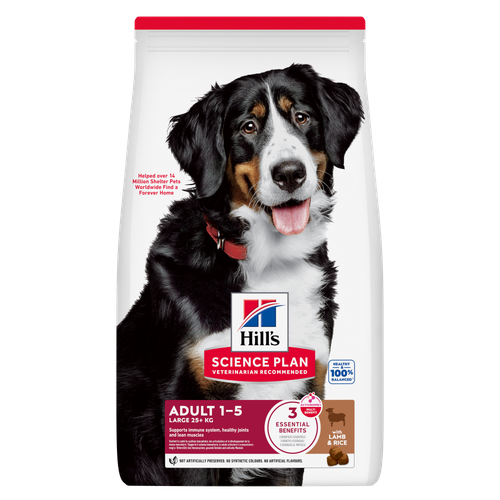
-
Find the right food for your petTake this quiz to see which food may be the best for your furry friend.Find the right food for your petTake this quiz to see which food may be the best for your furry friend.Featured products
 Large Breed Adult Dog Food
Large Breed Adult Dog FoodHill's Science Plan Large Breed Adult Dog Food with Lamb & Rice is a complete pet food, specially formulated with ActivBiome+ Multi-Benefit Technology.
This food is specifically designed to fuel the energy needs of large breed dogs during the prime of their life.Shop Now Perfect Digestion Large Breed Puppy Food
Perfect Digestion Large Breed Puppy FoodPrecisely balanced nutrition with Hill's ActivBiome+ prebiotic blend actively contributes to supporting digestive health and overall wellbeing to help your pet feel their best
Shop Now Adult Light Dog Food
Adult Light Dog FoodHill's Science Plan Light Adult Wet Dog Food is a complete premium pet food for adult dogs that tend to gain weight easily. This deliciously smooth loaf is formulated to deliver the appropriate amount of energy to support weight maintenance in adult dogs.
Shop NowFeatured products CULINARY CREATIONS ADULT CAT FOOD
CULINARY CREATIONS ADULT CAT FOODHill's Science Plan CULINARY CREATIONS Adult cat food with Salmon & Carrots was formulated to provide a great-tasting experience to cats. Its delicious flavour and texture are combine with essential nutrients to support cats' optimal health during the prime time of their life. Specially formulated with high-quality salmon protein, essential taurine for heart health & balanced minerals to support kidneys & bladder.
Shop Now Adult Cat Food
Adult Cat FoodHill's Science Plan Adult Cat Food with Chicken is a complete pet food, specially formulated with ActivBiome+ Multi-Benefit Technology.
This food is specially formulated to fuel the energy needs of cats during the prime of their life.Shop Now Sterilised Adult Cat Food
Sterilised Adult Cat FoodHill's Science Plan Adult Sterilised Cat Dry Food with Salmon is specially formulated with ActivBiome+ Multi-Benefit Technology. It is a precisely balanced nutrition, tailored to meet the needs of sterilised cats, to help keep sthem lean & healthy.
Shop Now -
Dog
- Dog Tips & Articles
-
Health Category
- Weight
- Food & Environmental Sensitivities
- Urinary
- Digestive
- Joint
- Kidney
-
Life Stage
- Puppy Nutrition
- Adult Nutrition
- Senior Nutrition
Cat- Cat Tips & Articles
-
Health Category
- Weight
- Skin & Food Sensitivities
- Urinary
- Digestive
- Kidney
-
Life Stage
- Kitten Nutrition
- Adult Nutrition
Featured articles The Incredible Science Behind Your Pet's Microbiome
The Incredible Science Behind Your Pet's MicrobiomeLearn what your pet's microbiome is, how it contributes to your pet's gut and overall health, and why nutrition is important in maintaining healthy microbiomes.
Read More Microchipping: The Facts | Hill's Pet
Microchipping: The Facts | Hill's PetThe government has announced that as of April 2016, all dogs in the UK must be microchipped by law.
Read More Pet Nutrition: What Makes "Healthy" Pet Food Healthy? | Hill's Pet
Pet Nutrition: What Makes "Healthy" Pet Food Healthy? | Hill's PetIn people, the right diet is very important. If you are eating the wrong way for your metabolism, activity level, age and lifestyle you could end up with health issues.
Read More -


Humans have the amazing ability to recognize the facial and body cues of anxiety in other human beings, but do you know how to read the signs of stress in dogs? When dealing with canine companions, it's of the utmost importance that you're able to understand their methods of communicating tension. Once you're speaking the same "language," you can employ several methods of stress relief for dogs that'll put their mind at ease.
What Does Stress in Dogs Look Like?
Stress isn't always easy to diagnose in our human counterparts, so you can imagine how difficult it can be to recognize in your dog that can't tell you they're stressed, so it's important to look for the signs of anxiety in dogs. When a dog's anxiety is overlooked, it can lead to a multitude of unwanted behaviors that may harm the relationship between you two. Unfortunately, simply addressing the behavior problems doesn't always remove all unwanted behaviors. If you don't address the source of your dog's anxieties, these behaviors can continue manifest. While bad behaviors may still occur, looking to address your dog's stress can go a long way to reducing them.
Learning the signs of stress in dogs is the first step to fostering a fulfilling and happy bond with your pup. Some common signs of stress in dogs, according to the American Animal Hospital Association, include:
- Loss of appetite
- Avoidance and apathy
- Digestive trouble such as vomiting, diarrhea or increased flatulence
- Excessive licking and chewing, sometimes to the point of self-mutilation
- Seeking constant attention or contact
- Destructive behavior (such as chewing up furniture, pillows, shoes, etc.)
- Crouched body posture with body lowered, tail tucked and ears back
- Mouthing, which can range from nibbling to snapping or biting
- Increased or altered sleeping patterns
- Increased vocalizations
- A tense body, panting, trembling and tight muscles
- Excessive shedding
- Increased patrolling and sniffing
- Urination or defection accidents
- Abnormal, repetitive behaviors such as tail chasing, chewing paws or licking lips
- A grimace that appears as a smile


Tasty Tips
Common Causes of Stress in Dogs
Just like with humans, change is a stressor for dogs, and some struggle more than others to adapt. Additionally, exposure to unfamiliar people, places or animals; or, on the opposite end of the spectrum, separation from familiar people, places or animals can cause your dog to feel anxious or stressed. According to the Merck Veterinary Manual, other common causes of stress include loud noises, such as thunderstorms and fireworks, punishment and a lack of physical exercise or mental stimulation.
Also, did you know that pain and stress can often manifest as similar signs in dogs? If you believe that your dog is stressed, they might actually be in pain. For this reason, if you notice any of the above signs, you should bring your dog to the veterinarian to get a checkup. The last thing you want to do is simply treat the symptoms, when there is a larger underlying health condition to be concerned with.
Finally, did you know that you can be a cause of your dog's stress? Now it's not what you're thinking. Dogs are great at mirroring the emotions of their owners — so in other words, if your are stressed, your dog could be picking up on that anxiety causing them to be stressed as well. If you notice your dog's behavior has changed lately, it might be worth examining any changes in your own life. If you are worried about work, relationships or a move, you might not realize that you are transferring those worries to your dog. A good method to overcome these anxieties is to just spend time bonding with your dog and assure them everything is okay — in fact, chances are that this may help ease some of your stress too.

Calming Products for Dogs
Many items are available online and in pet stores that are specifically designed to help pet parents provide stress relief for dogs.
These include products containing dog appeasing pheromone (DAP), which mimics the pheromones of a canine nursing mother for a stress-relieving effect. It can be found in a variety of items, such as collars, plug-in diffusers, wipes and sprays.
Storm capes and calming vests may also offer relief to anxious pooches. The theory is that gentle pressure helps calm down dogs during anxiety-triggering situations. Storm capes even help discharge static electricity that builds up during storms to provide further comfort to dogs.
Certain supplements and pharmaceuticals may also provide stress relief for dogs, including:
- Solliquin: A supplement containing plant extracts that can help promote a calming effect.
- Zylkene: A supplement that can be used long term or short term to ease anxiety. It can be administered two days before a stressful event to ease anxious behaviors.
- Sileo: A Food and Drug Administration-approved medication for the treatment of canine noise fears. It can be taken alone or with other anxiety medications or supplements.
While your vet may recommend supplements, know that there are other options as well. For instance, there are therapeutic pet foods out there that are formulated with stress-alleviating ingredients in them as well. Something as simple as changing their food could go along way at helping them ease anxiety.
The list of prescription medications and antidepressants available for dogs with generalized anxiety and stress disorders is always growing. If you think your dog may benefit from one of these options — or from medication, in general — schedule a visit with your veterinarian to determine the best course of action.
Best Practices for Stress Relief in Dogs
Beyond medication, there are some additional things you can try with your dog as part of a more holistic stress-relief program. Consider trying any of the following:
- Scheduling regular exercise and playtime with them. Note: Daily walks may not be enough.
- Avoiding situations and places that are known to trigger stress whenever possible. Taking your dog to a crowded place such as an outdoor festival or farmers market, while well-intentioned, may end up stressing them out.
- Providing a safe zone. This can be wherever they feel comfortable, from a bed to doghouse. Giving them a sweatshirt or blanket that smells like you can go a long way toward easing anxieties when you're out of the house.
- Setting consistent rules and not changing them. Your dog must know what you expect from them. And don't forget to reward positive behavior and ignore bad behavior. If you always run to your dog's rescue when they seem stressed, they will pick up on this and use it to their advantage. Part of being a pet parent is learning when you need to consul them versus when it's only reinforcing a bad behavior.
- Providing them with a complete and balanced food to promote their well-being — body and mind.
It's important to understand, that not all anxious behaviors in dogs can be cured, so to speak. Much like humans, some anxiety-related behaviors are lifelong, and as their pet parent, it is your job to help them manage them the best you can. Above are a number of possibilities for treating stress in dogs, but your veterinarian will be able to best determine the cause of the anxiety and the course of treatment. Understanding this is important, as is how you respond to their stress-specific behaviors. Try to remain calm around your dog, rewarding good behavior, while avoiding scolding or punishing them for unwanted behaviors.


Dr. Laci Schaible is a small animal veterinarian, veterinary journalist, and a thought leader in the industry. She received her Doctor of Veterinary Medicine from Texas A&M University and her Masters in Legal Studies from Wake Forest University.
Related products

Hill's Science Plan Large Breed Adult Dog Food with Lamb & Rice is a complete pet food, specially formulated with ActivBiome+ Multi-Benefit Technology.
This food is specifically designed to fuel the energy needs of large breed dogs during the prime of their life.

Precisely balanced nutrition with Hill's ActivBiome+ prebiotic blend actively contributes to supporting digestive health and overall wellbeing to help your pet feel their best

Hill's Science Plan Adult Wet Dog Food with Turkey is a complete premium pet food for adult dogs from 1 year. This deliciously smooth minced turkey loaf is formulated to deliver the appropriate amount of energy to support the needs of adult dogs.

Hill's Science Plan Light Adult Wet Dog Food is a complete premium pet food for adult dogs that tend to gain weight easily. This deliciously smooth loaf is formulated to deliver the appropriate amount of energy to support weight maintenance in adult dogs.
Related articles

Learn to see the signs of an upset stomach in your dog, understand the triggers and explore some possible solutions.

Dog obesity is a significant problem - learn more about helping your dog become trimmer and healthier through improved nutrition.
Discover the causes, signs, and treatments of kidney disease in dogs and find methods of supporting your dog's kidney health. Learn more at Hill's Pet.

Gurgling tummies in turmoil are not good news for pets. Owners who have to clean up the unfortunate consequences, digestive problems are one of the rare downsides to owning a pet.

Put your dog on a diet without them knowing
Our low calorie formula helps you control your dog's weight. It's packed with high-quality protein for building lean muscles, and made with purposeful ingredients for a flavourful, nutritious meal. Clinically proven antioxidants, Vitamin C+E, help promote a healthy immune system.
Put your dog on a diet without them knowing
Our low calorie formula helps you control your dog's weight. It's packed with high-quality protein for building lean muscles, and made with purposeful ingredients for a flavourful, nutritious meal. Clinically proven antioxidants, Vitamin C+E, help promote a healthy immune system.

